

For businesses engaged in injection molding, the key to producing top-notch plastic parts lies in understanding and calculating the tonnage of the injection molding machine. In this article we will answer your question of how to Calculate Injection Molding Machine Tonnage and delve into the intricacies of injection molding machine tonnage, exploring its significance, key parameters, calculation methods, and practical applications. By the end, you'll not only comprehend the importance of accurate tonnage calculation but also discover optimization strategies that can revolutionize your injection molding processes.
Injection molding machines, pivotal in plastic product manufacturing, rely on tonnage to exert clamping force. This force is crucial for molding plastic granules into specific shapes within a mold cavity. Remember to use machines with different tonnages to produce different plastic products, and too large or too small a tonnage will affect product quality and production efficiency.

Mold size is a critical parameter influencing the tonnage calculation of an injection molding machine. The mold, part of the mold shaping, dictates the area the clamping force must act upon. Larger molds inherently demand higher tonnage due to the increased surface area on which the machine must exert force. The relationship between mold size and tonnage is fundamental choosing the right tonnage based on mold size is instrumental in achieving successful and efficient injection molding processes.
The size and weight of the part being produced are pivotal factors in determining the required tonnage. One thing to take in consideration that all the heavy parts of the machine will require heavy tonnage to make the machine work perfectly by overcoming the resistance. The tonnage will work as the part that will overcome the force posed by the size and weight of the machine. Thus, calculating the tonnage is accurately one of the most important part in the whole procedure.
In order to calculate the tonnage the material that is being use din also one of the important factor. However, different materials show different characteristics like viscosity, flow ability and resistance to get damaged. Not only this but different materials require different tonnage to ensure optimal molding conditions. The tonnage for molding a flexible material like PE differs from that required for a rigid material like ABS. Thus, it is important to know and understand type of material and its characteristics.
The clamping force is very important to keep the mold mouth close and this force is very related to tonnage. If the tonnage is high the clamping force is also required to be high. This is to maintain mold integrity and prevent any deformation or shifting during the injection process. The clamping force is particularly critical in ensuring that the mold stays securely closed as the molten material is injected, allowing for the precise formation of the desired product. Therefore, perfect tonnage calculation is same with achieving the required clamping force for the molding operation.
The melt flow rate is another important factor in calculating the tonnage. It represent the speed at which the plastic material flows through the injection molding machine. When the rate of melt flow is higher the more fluid material is required. This parameter is especially relevant in applications where a rapid injection of molten material is essential. So, when we understand the rate of flow we are actually facilitating ourselves in selecting the right tonnage. Because if we don’t then it may effect both quality and efficiency of the process.
The rate at which the plastic material is injected in the cavity directly effects the tonnage requirements. Higher injection pressures demand higher tonnages to facilitate the smooth and effective injection of the material. The pressure exerted during injection is vital for achieving the desired intricacies and details in the molded part. Calculating the tonnage based on injection pressure is essential for preventing issues such as incomplete filling of the mold or the formation of defects in the final product.

Clamping force (T) = Kp * Product projected area S * Safety factor (1+10%). Kp values vary based on material type.
Clamping force (T) = Material molding pressure * Product projected area S * Safety factor (1+10%).
Involves projected area (S) and cavity pressure influenced by various factors like gates, gate size, product thickness, and material viscosity.
(If you are still confused, you can contact our Customer Service on our website.)
· One common misconception is relying solely on the projected weight of the part to determine tonnage requirements. Depending solely on weight can lead to inaccuracies in tonnage calculation and suboptimal machine performance. While part weight is a factor, it doesn't encompass all the variables influencing the molding process, such as material type, part geometry, and flow characteristics.
· The next misconception is that if we keep the tonnage high it will get us higher quality. It is totally wrong as it will lead to inefficient results and higher expenses in every project.
· The third misconception is that if we keep the tonnage fix for every project the quality can be maintained. However, this is also a misconception this is because for different material, product or design the tonnage should be different, By keeping it save we can cause defect in final product.
To avoid mistakes it is important that we should follow some specific strategies. Some of them are as follows:
· The tonnage amount should be reviewed daily to know that everything is going fine because tonnage need can be changed with change in project details.
· As we have discussed above that different materials have different characteristics and these characteristics effect the results of the product. So if we consider the characteristics of these products and use the tonnages according to them the it will definitely giver high quality product and efficiency in our machines.
· The complexity and geometry of the part being molded influence the distribution of forces during the injection process. By taking in consideration the geometry we can get high quality results.
· There are some factors that can affect the tonnage requirements and these are melting temperature, cooling time etc. So the tonnage should be check daily.
How to Calculate Injection Molding Machine Tonnage is very important if we want to generate perfect molding procedure. By understanding the other factors of machine we can tailor their tonnage requirements to match specific applications so that we can maximize output. When we consider and practice the strategies that are mentioned above it will further enhances overall performance and cost-effectiveness. Continuous improvement, rooted in the avoidance of common misconceptions, ensures that manufacturers stay adaptive and deliver consistent, high-quality results, thus providing lasting value to their customers in the competitive realm of injection molding.
